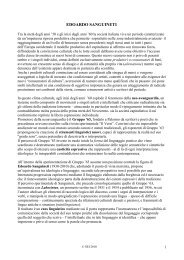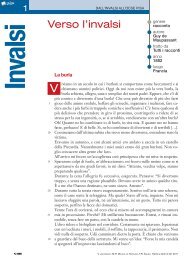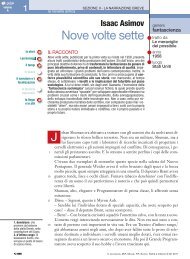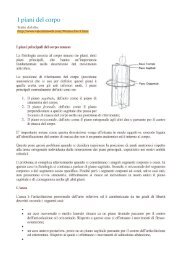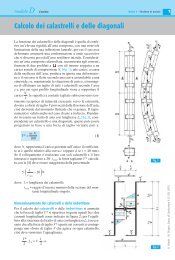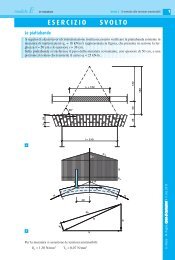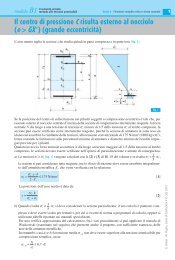Create successful ePaper yourself
Turn your PDF publications into a flip-book with our unique Google optimized e-Paper software.
132 I FENOMENI ENDOGENI<br />
CONTENT AND LANGUAGE INTEGRATED LEARNING CLIL<br />
Short-Term Prediction<br />
In contrast to regional predictions, short-term predictions attempt<br />
to forecast the specific time and place of an impending<br />
eruption. They are based on instruments that monitor an active<br />
volcano to detect signals that the volcano is about to erupt.<br />
The signals include changes in the shape of the mountain and<br />
surrounding land, earthquake swarms indicating movement<br />
of magma beneath the mountain, increased emissions of ash<br />
or gas, increasing temperatures of nearby hot springs, and any<br />
other signs that magma is approaching the surface.<br />
In 1978, two U.S. Geological Survey (USGS) geologists, Dwight<br />
Crandall and Don Mullineaux, noted that Mount St. Helens<br />
had erupted more frequently and violently during the past<br />
4,500 years than any other volcano in the contiguous 48 states.<br />
They predicted that the volcano would erupt again before the<br />
end of the century.<br />
In March 1980, about two months before the great May eruption,<br />
puffs of steam and volcanic ash rose from the crater of<br />
Mount St. Helens, and swarms of earthquakes occurred beneath<br />
the mountain. This activity convinced other USGS geologists<br />
that Crandall and Mullineaux’s prediction was correct.<br />
In response, they installed networks of seismographs,<br />
tiltmeters, and surveying instruments on and around the<br />
mountain.<br />
2 Aerial view of pyroclastic flow deposits from the Mount Pinatubo eruption 1991.<br />
Swarm: fig. a group of bees<br />
Ash: the grey substance left when something is burnt completely<br />
Nearby: that is a short distance away<br />
Steam: the gas or vapour that rises from boiling water<br />
In the spring of 1980, the geologists warned government agencies<br />
and the public that Mount St. Helens showed signs of an<br />
impending eruption. The U.S. Forest Service and local law enforcement<br />
officers quickly evacuated the area surrounding the<br />
mountain, averting a much larger tragedy.<br />
Using similar kinds of information, geologists predicted the 1991<br />
Mount Pinatubo eruption in the Philippines, saving many lives 2 .<br />
Although the June 25, 1997, eruption of the Soufrière Hills volcan<br />
on the Caribbean island of Montserrat killed 19 people and destroyed<br />
many homes and farms, predictions of the eruption by<br />
the Montserrat Volcano Observatory saved many additional lives.<br />
The island was long known to harbor an active volcano, and the<br />
observatory was established to monitor the volcano and to predict<br />
eruptions.<br />
The observatory recorded continued swelling of the dome,<br />
swarms of earthquakes, and many large and small eruptions, including<br />
pyroclastic flows, through the rest of 1996 and the first<br />
half of 1997. On June 25, 1997, major pyroclastic flows reached<br />
to within 50 meters of the airport. Surges and flows devastated<br />
several communities, killing 19 people.<br />
Although some people returned to homes and farms during<br />
lulls in the long eruptive sequence, there is little doubt that the<br />
warnings issued by the observatory and evacuations ordered by<br />
the government saved many lives.<br />
True or false<br />
from Thompson-Turk, Earth Science and Environment, 4E. © 2007.<br />
1. Regional predictions attempt to forecast the<br />
specific time and place of an impending eruption. T F<br />
2. The potential violence of a volcanic eruption<br />
is related to the geological environment<br />
of the volcano. T F<br />
3. Earthquake swarms, emissions of ahes and gases<br />
and puffs of steam are important signal<br />
in short-term prediction of volcanic eruptions. T F<br />
4. Short-time predictions always save human lives. T F<br />
5. If an active volcano lies on continental crust,<br />
the eruption may be gentle because granitic<br />
magma may form. T F<br />
6. If an active volcano lies on oceanic crust,<br />
the eruption may be gentle because basaltic<br />
magma may form. T F<br />
to Harbor: fig. to host<br />
Dome: the rounded summit of a hill or mountain; (geology) a rounded<br />
uplifted landform or underground structure<br />
Lull: a temporary period of quiet or inactivity<br />
© SEI – 2012



